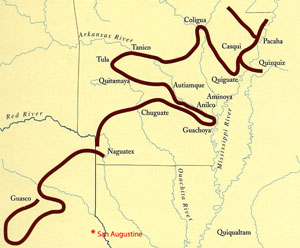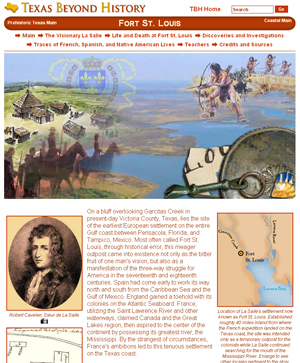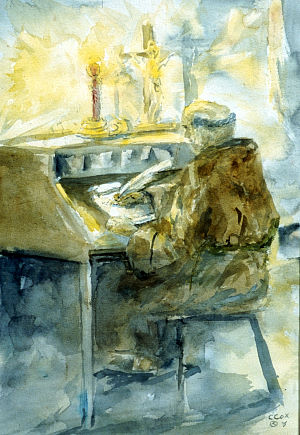Who Abandoned the East Texas Mission San Francisco De Los Tejas but Wanted to Return to Try Again
The Castilian were the commencement Europeans to enter Deep East Texas when the De Soto Trek entered the area in 1542 under the control of Luis de Moscoso following Hernando de Soto'due south death at the Mississippi River. Earlier interpretations of the route of this trek maintained that this grouping passed through what is now San Augustine, merely virtually contempo interpretations accept Moscoso's road westward of San Augustine, passing through modern twenty-four hours Nacogdoches. Moscoso and his group establish no gold or silver, and while they left no settlers behind, they did leave Spanish horses, hogs, and diseases. The immediate impact is unknown, simply it is likely that deadly Onetime World diseases began spreading amongst the native peoples of East Texas, triggering social changes as Indian groups struggled to cope with population loss.
The French first visited the Cenis (Hasinai Caddo) surface area of Deep Eastward Texas during the occupation of La Salle'south Fort St. Louis (1685-1689) on the Gulf coast, only like the early Spanish explorers, their trails were well to the west of San Augustine, close to the Neches River.
The Ais Indians occupied the expanse around San Augustine but it was the Hasinai to the due west who invited the Spanish dorsum into East Texas. La Salle's failed attempt at establishing a fort on the Gulf coast defenseless the attention of the Spanish, who sent several unsuccessful expeditions to discover the French fort. During one of these expeditions the Spanish encountered a group of Hasinai who proclaimed themselves tayshas or allies (a term which became Tejas and then Texas) and asked the Spanish to come settle in their homeland of East Texas. This invitation prompted the establishment of two Spanish missions in 1690, San Francisco de los Tejas—located almost modern-day Weches, Texas, and Santísimo Nombre de María, located on the Neches River, 5 miles to the east of San Francisco. Santísimo Nombre de María was destroyed by a alluvion in 1692 and San Francisco de los Tejas was abased a yr afterwards at the insistence of the local Hasinai after misbehavior by Spanish soldiers and their cattle. Castilian soldiers were making inappropriate advances to the Hasinai women and Spanish cattle were wrecking havoc on Hasinai gardens.
In the following decades, Father Francisco Hidalgo, formerly of Mission San Francisco, was determined to return to E Texas and minister to the Tejas (Caddo) peoples. In 1711 Hidalgo wrote what turned out to exist an important letter to the governor in French Louisiana, Antoine de la Mothe, Sieur de Cadillac. Father Hidalgo was disappointed that the Castilian would not fund his return to East Texas, and he offered to introduce Cadillac to Castilian traders in exchange for French back up of his mission in E Texas. Two letters were sent past courier from Presidio San Juan Bautista on the Rio Grande and when one arrived in Mobile, it was after the French had been rebuffed in their attempts to establish trade relations with the Spanish at Vera Cruz—one French ship loaded with trade goods had been seized by the Spanish on its way to Vera Cruz and the ship was sent back to Louisiana without its cargo in 1710 considering merchandise between the French and New Kingdom of spain was forbidden by the Spanish Crown.
Cadillac instructed Louis Juchereau de St. Denis to try to detect Father Hidalgo. St. Denis had visited the area of the Natchitoches Indians in 1700 and in 1713 he returned at that place, established a trading postal service, and proceeded across the state of the Tejas to Presidio San Juan Bautista. In result, the French had failed to plant trade relations through the "front door" at Vera Cruz and so they tried once again through the "dorsum door" at San Juan Bautista. St. Denis and his men were arrested at Presidio San Juan Bautista past Commandant Diego Ramon and held under house abort. It has been suggested that the families of Ramon and St. Denis had previous commercial relations, and these relations were made more personal by Louis Juchereau marrying María Manuella Sánchez de Navarro, the step granddaughter of Diego Ramon. It's not known if St. Denis ever found Father Hidalgo, but Hidalgo's letter and St. Denis's travels to try to detect him resulted in the Castilian development of Texas.
The Spanish-French interaction foretold the founding of Mission Dolores. Elsewhere in this website readers tin learn more about the Caddo peoples, the well-nigh populous and powerful native groups in Due east Texas by studying the special exhibit, Tejas: Life and Times of the Caddo. More of the historic background leading to the render of Castilian missionaries and soldiers to the region can exist found in the Cultural Worlds section of the TBH exhibit on Los Adaes.

The route of the De Soto entrada in 1542 through the Caddo Homeland equally reconstructed past Charles Hudson. ![]()

Fort St. Louis on Texas Beyond History. ![]()

Artist's delineation of Franciscan missionary Father Francisco Hidalgo writing a letter offering to introduce the French governor of Louisiana to Castilian merchants in substitution for the Castilian supporting his unfinished missionary work in east Texas. This letter would ultimately consequence in the institution of Los Adaes. Image courtesy George Avery, original watercolor by Cornial Cox, copyright to Cornial Cox.
Source: https://www.texasbeyondhistory.net/dolores/before.html